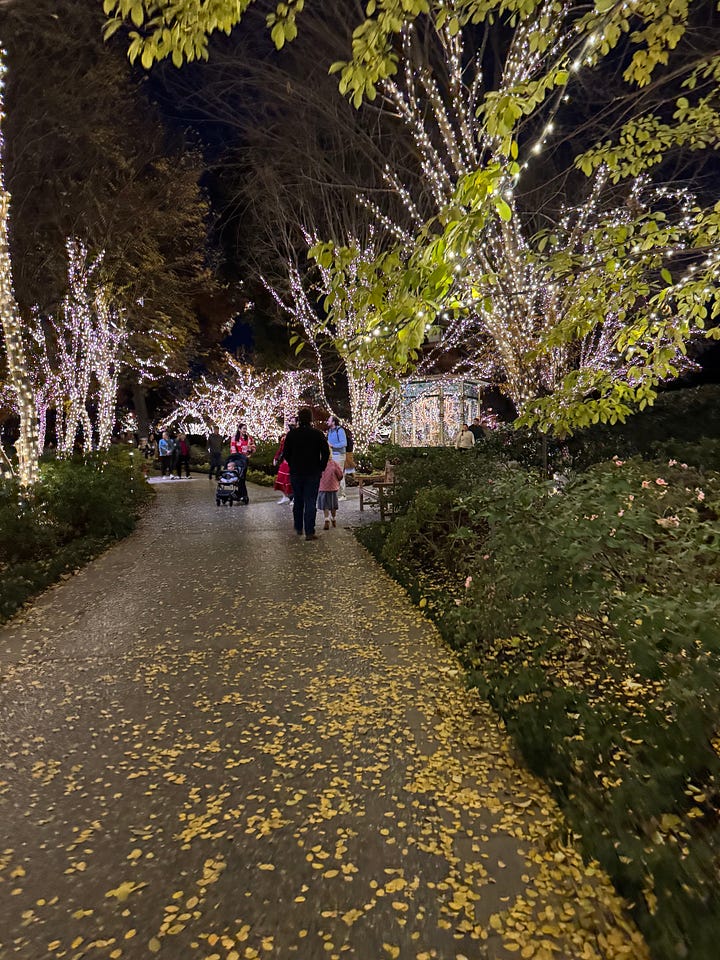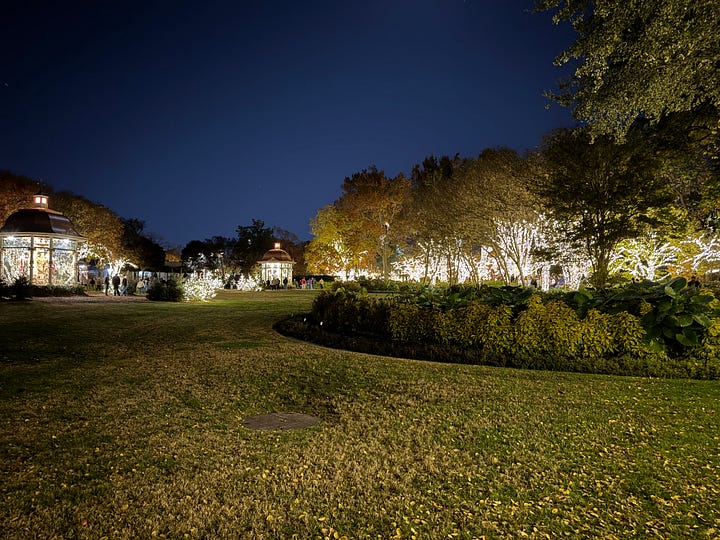As the calendar turns and another year prepares to close its final chapter, there’s a natural pull to look back on where we’ve been, what we’ve accomplished, and where we might be headed next. Whether you’re an employee aiming to impress your company’s leadership team, an entrepreneur striving to deliver exceptional value to customers and stakeholders, or an investor nurturing long-term prosperity for yourself and your loved ones, now is the time to lean into an annual performance review.
Annual Performance Review - a Holiday Tradition




For many years, when I worked in a corporate environment, that review was a holiday tradition—pored over and polished before my seasonal break. I would collect the highpoints of our team’s achievements, marveling at how, together, we realized accomplishments that once seemed out of reach. Nothing beats the feeling of seeing what collective effort can yield, especially when the final product of our teamwork emerges as something far greater than the sum of its parts. Indeed, we’re better together.
Since stepping away from my corporate career three years ago, my perspective on this annual reflection has deepened. No longer confined to performance frameworks set by an organization, I can excavate my own year more freely. I dig into the layers of what worked, what didn’t, and where my energy can be channeled to generate more meaningful results. I’ve found myself in “research mode”—sifting through personal habits, strategies, and tools to understand how best to grow, create, and thrive on my own terms.
Learning the Art of the Annual Review
Back in my corporate days, the concept of an annual review wasn’t something I inherited from family traditions. It was a skill developed as an adult, shaped by the company’s structures and accountability measures. In the beginning, my reviews were overwhelmingly task-oriented: lists of what I’d done and projects I’d touched. I recall sifting through old emails to jog my memory and piece together a cohesive narrative of my year’s work. It was functional, sure, but not necessarily inspiring.
Over time, as my responsibilities grew, I realized I needed a different system—something more strategic, thoughtful, and outcome-focused. Goals, outcomes, narratives, and resource allocation became the heart of my reviews. It wasn’t just about tallying completed tasks; it was about telling a story of achievement, learning, and leadership. I needed to show why my team deserved recognition, resources, and the trust to tackle even bigger challenges in the year ahead.
My planning and reflecting skills sharpened out of necessity and with feedback from mentors and colleagues. Initially, I wrote too much, struggled to distill my thoughts, and experimented relentlessly with different planning tools and systems. Along the way, I discovered that “planning and reflecting” isn’t a one-size-fits-all solution; it’s a life skill that’s continuously evolving. We each must find a method that resonates with our own style of thinking, organizing, and creating.
From Long Hours to Lasting Impact
Cal Newport’s concept of “slow productivity” caught my eye recently. In an age where we’ve moved from industrial metrics to knowledge-based work, old measurements of productivity—like lengthy hours logged—don’t necessarily translate into meaningful progress. I remember my early years in a demanding corporate role, feeling compelled to stay late simply to prove my diligence. Overextended, I often focused on “fixing”—plugging holes, streamlining processes, erasing inefficiencies.
But as my career advanced, I recognized a pattern: I was spending more time repairing the past than building the future. While fixing and refining are important, they can’t be the entire story of a career or a life. True progress involves creation, innovation, and growth. As we look back at our accomplishments this year, we should ask ourselves: Have we invested more in building and nurturing new ideas, or have we been stuck putting out fires? Both tasks have merit, but leaning toward creation can propel us to a more prosperous and meaningful professional journey.
Tools and Tactics for Meaningful Reviews
If you’re still experimenting with how best to structure your annual review, you’re not alone. Each of us has a unique conative style—our own natural way of striving, organizing, and thriving. Some of us think best early in the morning, others late at night. The point is to find a method that fits you, not to force yourself into a mold that feels unnatural.
Here are a few tools and frameworks that have helped shape my own evolving system:
The Full Focus Planner:
This analog tool helps you set big goals, plan action items, and then regularly review what you’ve accomplished. I’ve tried countless systems—GTD, Sunday Boxes, you name it—and over time, I’ve pieced together a hybrid that supports my unique thinking style. Each Sunday, I reflect on what worked, what didn’t, and what I learned. There’s something grounding about this ritual. It reminds me that we’re either winning or learning—both outcomes fuel growth.Annual Goal-Setting Guides:
Sahil Bloom’s 2025 Annual Planning Guide: I especially love the concept of “anti-goals,” identifying what you don’t want as a way to clarify what you do.
Jay Papasan’s Couple’s Planning Retreat: While I may not love the document’s title, it’s a great resource for joint goal-setting and ensuring all stakeholders in your life are aligned.
Kolbe Index:
This assessment helps you understand your conative abilities—how you naturally strive and solve problems. Over time, I’ve seen that my inherent approaches to work have remained consistent. Aligning tasks and goals to fit these natural tendencies can streamline progress and productivity. If a goal feels like swimming upstream, reconsider whether it aligns with your natural inclinations. Assessment Link
Think in Longer Horizons
One profound shift I’ve embraced is rethinking my relationship with time. Instead of always racing against the clock, I’m challenging the assumption that fast is always better than slow. Inspired by Dan Sullivan’s concept of the 25-Year Plan and Cal Newport’s Slow Productivity , I’ve realized that expanding our time horizons can unlock new levels of creativity, patience, and depth.
By setting a longer-term vision—10, 15, even 25 years into the future—we can stop chasing frantic, short-term wins and start building something more meaningful. This perspective grants permission to experiment, fail, learn, refine, and grow. Measuring progress becomes less about how many hours we put in and more about the magnitude of our outcomes over time. It allows us to shift from scarcity thinking—time is running out!—to abundance thinking—time is a canvas, waiting for creative strokes.
From Here to a Bigger, Bolder Future
As we edge closer to 2025, let’s commit to planning, measuring progress, and maintaining a balanced view of productivity. Consider how to blend creation and elimination in your work: build something new while gracefully letting go of what no longer serves you. Embrace the concept of a 25-year timeline, even if you don’t plan that far ahead. Thinking bigger and longer can help you relax and be in the present and focus on work that truly matters.
The beauty of this kind of reflective planning is that it’s never too late to start, and there’s no “right” way. Every system you try, every planner you fill, every assessment you take, is an opportunity to refine how you engage with your work and your life. You are creating your own masterpiece —you!
As we step into a new year, may we all embrace the art of reflective planning. May we balance fixing with growing, timelines with timeless goals, and hard work with genuine creativity. After all, achieving a 25-year dream might happen sooner than we think—especially when each quarter, each review, each moment of mindful adjustment, counts as a gentle step toward a richer, more fulfilling future.
Merry Christmas and Happy Holidays! Cheers to you and all you have accomplished, and more importantly, cheers to who you are and what you mean in this world.
Most sincerely,
Rachel
Note: thanks to AI for helping to essentialize my blog and notes to this beautiful post.




